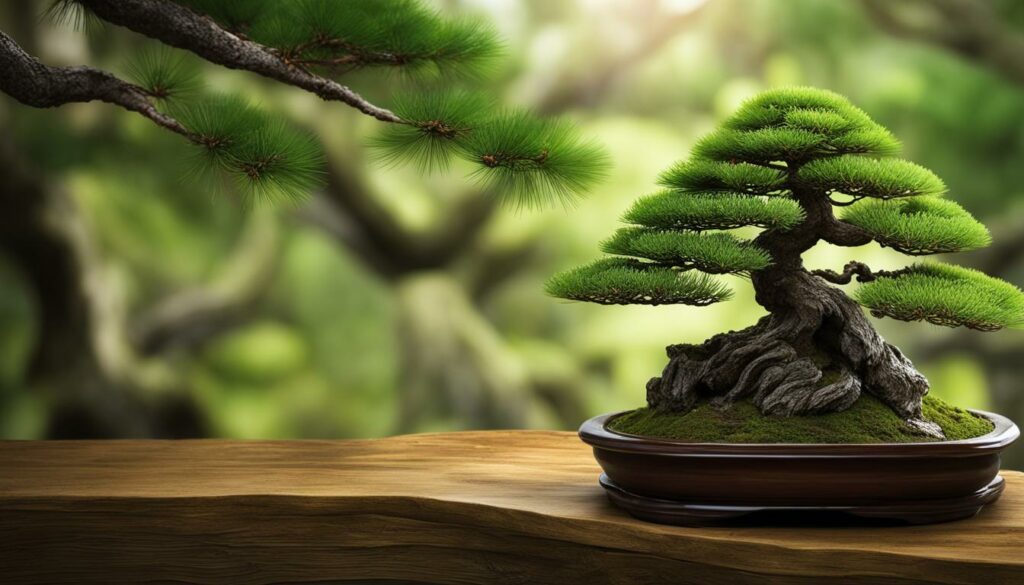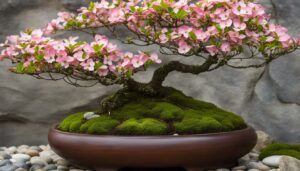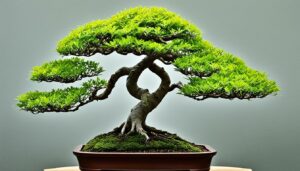If you’re looking for a resilient and striking bonsai species, look no further than the sturdy pines. With their impressive structure, textured bark, and evergreen foliage, these trees are popular among bonsai enthusiasts around the world. Growing black and white pines may take some extra care, but the rewards are well worth the effort.
In this article, we’ll explore the key characteristics and care requirements of both black and white pine bonsai trees. We’ll also cover some expert techniques for shaping and styling your bonsai, along with tips for disease and pest control. Whether you’re a seasoned bonsai pro or just starting out, this guide will help you cultivate healthy and beautiful pine bonsai trees that can withstand the test of time.
Key Takeaways:
- Pine bonsai trees are known for their resilience and beauty.
- Proper care of black and white pine bonsai trees is essential to help them thrive.
- Growing outdoor pine bonsai can enhance their natural beauty and character.
- Expert techniques like wiring and shaping can help create stunning bonsai designs.
- The resilience and beauty of pine bonsai trees make them an excellent choice for any bonsai enthusiast.
Getting Started with Pine Bonsai Care
Whether you are a seasoned bonsai enthusiast or just starting, taking care of your pine bonsai requires specific techniques and attention to detail. Here are some essential tips to get started with pine bonsai care:
- Sunlight: Pine bonsai trees thrive in direct sunlight for at least four to five hours each day. Make sure to place them in a spot with ample natural light to promote healthy growth.
- Watering: Proper watering is crucial for pine bonsai trees. Ensure that the soil remains moist but not waterlogged, as overwatering can lead to root rot. During the hotter months, you may need to water more frequently.
- Soil: Pine bonsai trees require well-draining soil to prevent water from accumulating in the roots. A suitable mix should include coarse sand, peat moss, and Akadama.
- Pruning: Regular pruning is necessary to maintain the desired shape and size of your pine bonsai tree. Trim new growth, remove weak branches, and shape the trunk to keep your bonsai looking its best.
Benefits of Proper Pine Bonsai Care
Proper care and maintenance of your pine bonsai tree will not only promote healthy growth, but it will also enhance its natural beauty. With the right care techniques, your pine bonsai tree can become a masterpiece of art and nature. Be sure to follow these basic care requirements to enjoy the full potential of your pine bonsai.
“Proper care and maintenance of your pine bonsai tree will not only promote healthy growth, but it will also enhance its natural beauty.”
Exploring the Black Pine Bonsai
The black pine bonsai is a unique and elegant tree with distinctive features that sets it apart from other bonsai species. Black pines are more resilient than white pines as they can tolerate various growing conditions and recover quickly from damage.
Black pines are known for their needle-shaped leaves that grow in bundles of two. They have a rough-textured, deeply furrowed bark that creates an aged appearance. These trees produce small, brown cones that add to their decorative appeal.
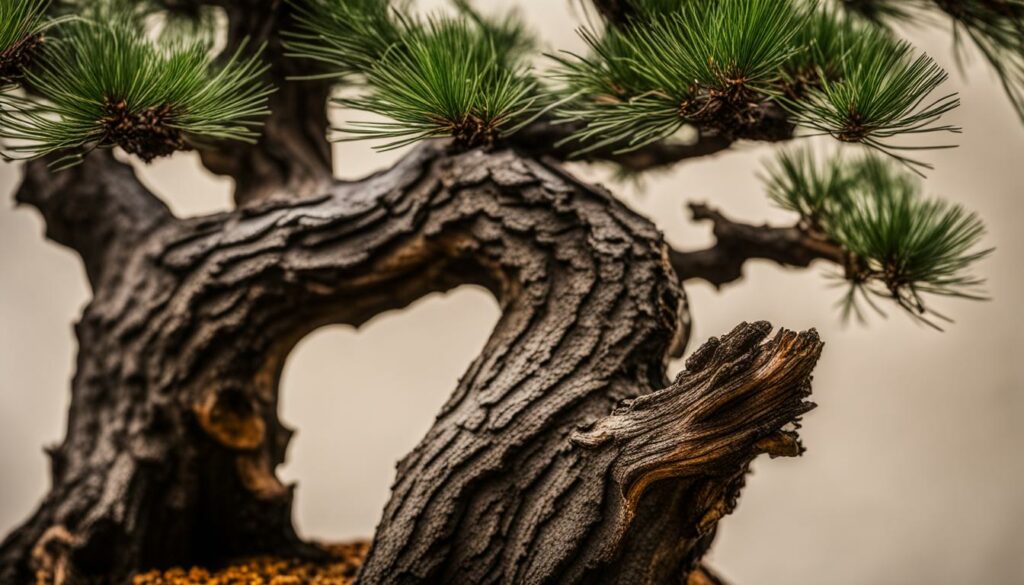
| Aspect | Soil | Watering |
|---|---|---|
| Full sun | Well-draining soil with organic matter | Adequate watering to prevent waterlogging |
Important Care Tips
Black pine bonsai requires proper care to thrive. Pruning is essential to maintain their shape and encourage new growth. Pinching back new candle growth will also keep them healthy and bushy. The wiring technique is recommended to shape and style black pines effectively.
They prefer a slightly acidic soil with low to medium fertility. Adding a slow-release balanced fertilizer in early spring, summer, and autumn is ideal. Bonsai black pine should be repotted every two to three years during the spring or autumn seasons.
“Black pine bonsai is a popular choice for enthusiasts because of its elegant appearance and resiliency. With proper care, it can be an excellent addition to your bonsai collection.”
The Beauty of White Pine Bonsai
White pine bonsai trees are known for their slender and elegant appearance, making them a popular choice among bonsai enthusiasts. They have soft, flexible needles that grow in clusters of five, giving them a unique texture that sets them apart from other bonsai tree species.
| Characteristic | Description |
|---|---|
| Growth rate | Medium. White pine bonsai trees can grow up to 12 inches per year in ideal conditions. |
| Preferred climate | Cool and moist. White pines are hardy trees that can withstand harsh weather conditions, but they prefer areas with mild temperatures and plenty of moisture. |
| Soil requirements | Acidic and well-draining. White pines prefer soil with a pH range of 4.5 to 6.0. They need good drainage to prevent root rot, so it’s essential to use well-draining soil. |
| Pruning and care | White pine bonsai trees require regular pruning to maintain their shape and size. Pinching back long shoots in the spring and fall helps to control the tree’s growth. They also need to be watered regularly to keep the soil moist, but not waterlogged. |
If you’re looking to create a stunning bonsai tree, white pine bonsai is a perfect choice. Its slender trunk and branches give it a graceful appearance that is both calming and elegant. With proper care and maintenance, your white pine bonsai can thrive for years to come.
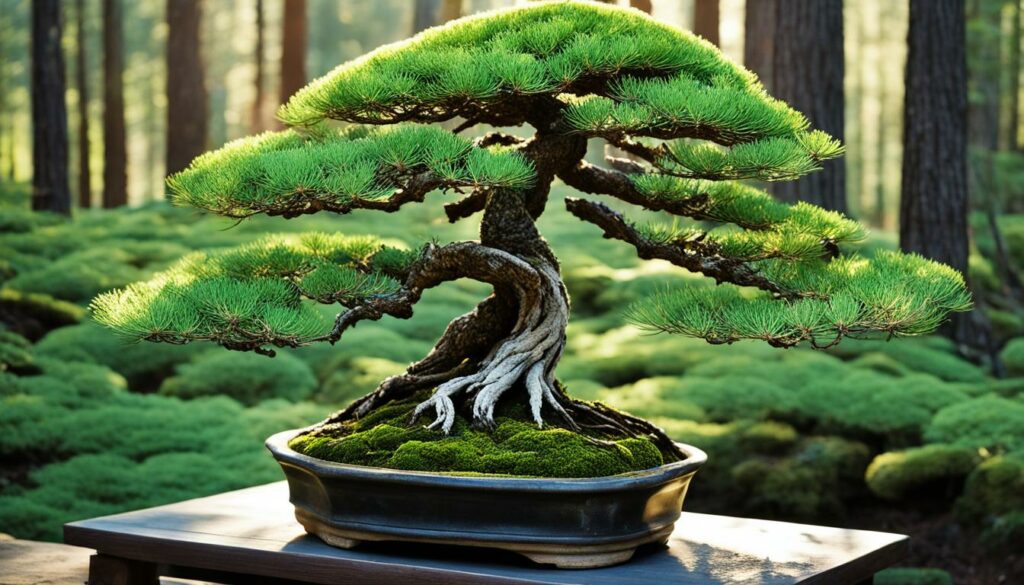
Outdoor Bonsai: Perfect for Nature Lovers
If you’re a nature lover, growing outdoor bonsai is a wonderful way to connect with the natural world. Outdoor bonsai trees, such as pine bonsai, are perfectly suited for cultivation in a variety of outdoor settings, from private gardens and patios to balconies and rooftops.
Exposure to the elements can enhance the personality of pine bonsai trees, allowing each specimen to develop its own unique character over time. Additionally, the changing seasons offer opportunities to showcase different aspects of the trees, from delicate new growth in spring to striking winter silhouettes.
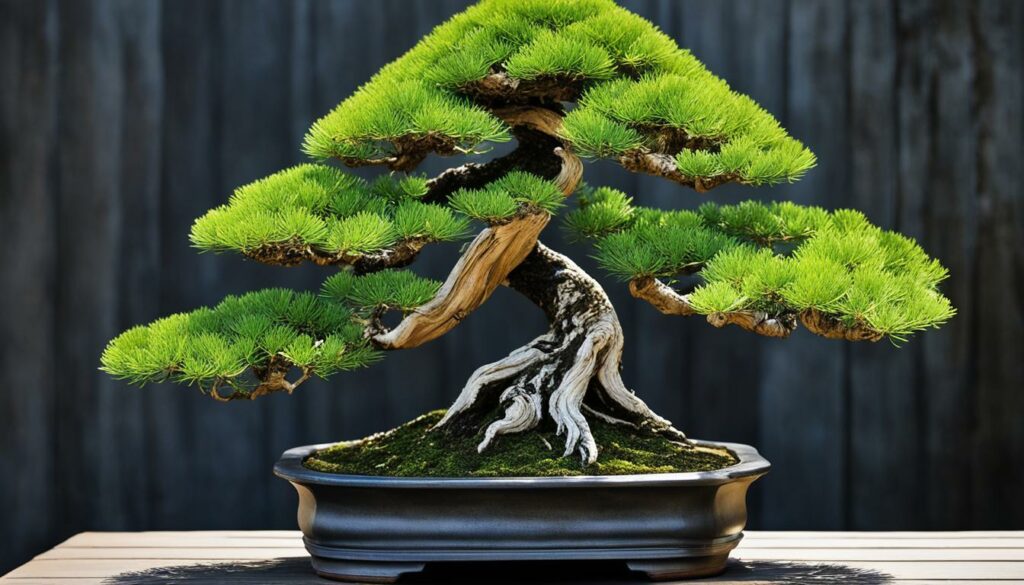
Creating an optimal environment for outdoor bonsai requires careful consideration of factors such as sunlight exposure, water and nutrient requirements, and soil type. For example, placing your pine bonsai in a spot that receives full sun for at least six hours a day can help ensure healthy growth and foliage. Adequate drainage is also important to avoid waterlogging and root rot, so be sure to use a well-draining soil mix and adjust watering frequency based on seasonal changes.
Overall, growing outdoor bonsai is a fulfilling and rewarding experience for nature lovers who appreciate the beauty and intricacies of the natural world. With proper care and maintenance, your pine bonsai tree can thrive and bring joy for years to come.
Expert Care Tips for Robust Black and White Pine Bonsai
Black and white pine bonsai care requires specialized techniques to achieve healthy and aesthetically pleasing results. Here are some expert tips:
Shaping Tips
To maintain the desired shape of your black or white pine bonsai, you should carefully remove any unwanted branches and needles. Use sharp scissors or pruning shears to avoid damaging the tree. When removing branches, cut at an angle to prevent sap from accumulating on the wound. Keep in mind that cutting back too much can weaken the tree, so plan your cuts strategically.
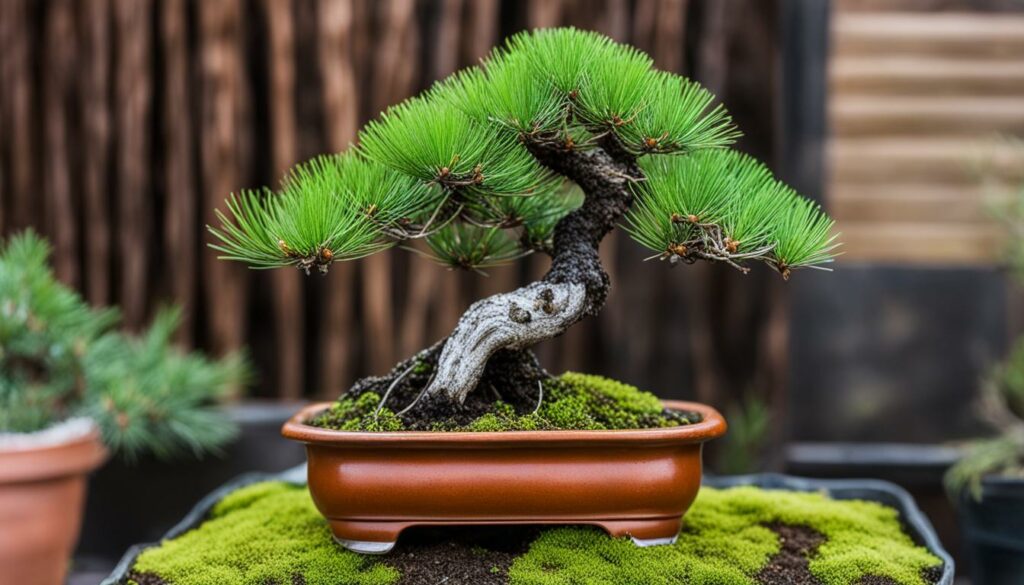
Wiring Techniques
Wiring is a vital aspect of bonsai care that allows you to bend and train branches into new positions. It’s best to wire pine bonsai during the spring or early summer when the tree is actively growing. Use wire that is about one-third the thickness of the branch you’re wiring, and be careful not to wrap the wire too tightly. After a few months, remove the wire to avoid damaging the tree.
Styling Advice
Styling your black or white pine bonsai is an art form that requires patience and careful consideration. Consider the overall shape and balance of the tree and aim to create a natural-looking design. You can also add interest by varying the height and angle of branches and by incorporating unique features like bark texture or trunk movement.
Disease and Pest Control
Preventing disease and pests is crucial for the health of your pine bonsai. Keep your tree in good sunlight, well-drained soil, and avoid over-watering. Periodically inspect your tree for pests and disease symptoms like wilting foliage, holes in the leaves, or discoloration. If you notice any issues, treat them promptly with organic solutions or consult a professional.
Showcasing the Resilience and Beauty
There’s something remarkably captivating about the resilience and beauty of bonsai tree species pines. These trees have been sculpted and trained to thrive in miniature form, exuding a serene and tranquil allure. From the black pine to the white pine, these trees possess a distinct mystique that speaks to the artistry and dedication of their caretakers.
In showcasing the unique charm of these trees, it’s difficult to overlook the enduring qualities that make bonsai tree species pines so popular. Take, for instance, the enduring legacy of the famed Japanese Black Pine, praised for its unyielding resilience and inherent beauty.
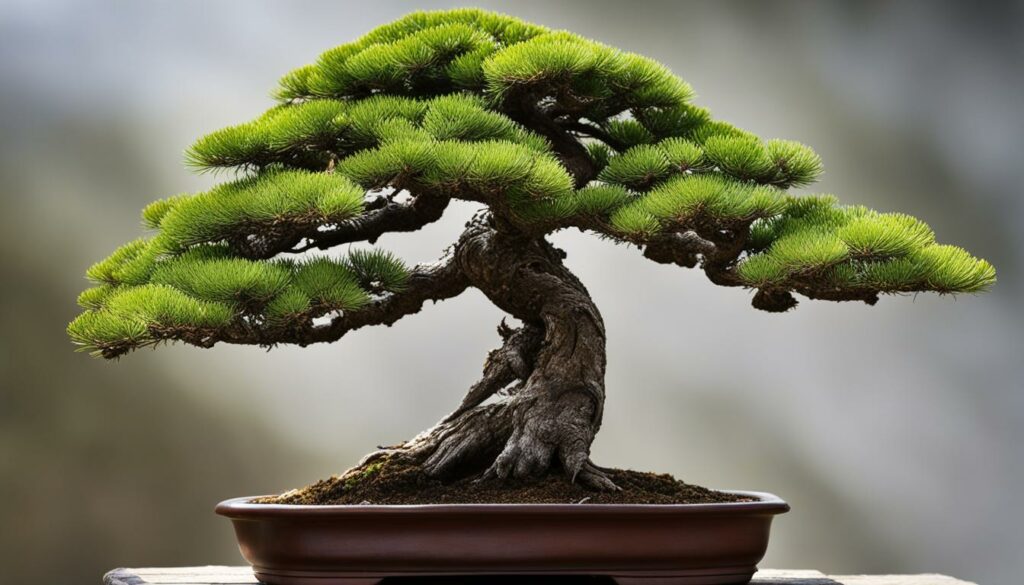
Or consider the majestic qualities of the Eastern White Pine, with its flowing needles and responsive growth habit. Both of these species, along with many others, have been masterfully crafted into works of art, testament to the creative potential of bonsai culture.
A Tribute to Bonsai Tree Species Pines: Inspirational Examples
“The pine tree seems to be one of nature’s greatest achievements-whether it’s a towering ancient pine on a mountaintop or a delicate pine bonsai, each one seems to embody a special kind of majesty.” – Anonymous
Indeed, the art of creating and maintaining bonsai tree species pines is a testament to the enduring beauty and artistry of nature. With these ornamental plants, one can take a tiny snippet of the natural world and shape it into a miniature masterpiece. The highly-detailed care and cultivation process for these trees involves everything from soil selection to precise pruning and wiring techniques.
Through inspiring and thought-provoking examples, we pay tribute to the remarkable resilience and beauty of bonsai tree species pines. Whether displayed in private collections or exhibited in galleries and shows worldwide, these trees represent the pinnacle of bonsai culture, a timeless tradition that continues to inspire and captivate enthusiasts around the globe.
Conclusion
Congratulations for completing this guide on bonsai tree species pines. By now, you have learned about the unique beauty and resilience of black and white pine bonsai trees, and the proper care techniques required to maintain their health and aesthetic appeal.
Remember, pine bonsai trees require special attention to sunlight, watering, soil, and pruning techniques. By following the tips and recommendations provided in this article, you can enjoy the beauty of these trees in your own garden, balcony, or indoor space.
Whether you prefer to grow your bonsai trees outdoors or indoors, black and white pine bonsai trees offer a great opportunity to showcase your skills and creativity in the bonsai art form. With expert care and maintenance, these trees can thrive for decades, providing you with a source of inspiration and joy.
We hope that this guide has inspired you to explore the world of pine bonsai trees, and that you now feel confident in caring for these beautiful and resilient plants. If you have any questions or feedback, feel free to reach out to us. Happy bonsai growing!
FAQ
What are the basic care requirements for pine bonsai trees?
Pine bonsai trees require lots of sunlight, regular watering, well-draining soil, and proper pruning techniques. It is also important to protect them from extreme temperatures.
How often should I water my pine bonsai tree?
The frequency of watering will depend on various factors, such as the climate and the size of the bonsai pot. Generally, it is recommended to water pine bonsai trees when the top layer of soil feels slightly dry.
Can I keep my pine bonsai tree indoors?
While pine bonsai trees can be temporarily kept indoors during colder months, they thrive best when grown outdoors, where they can receive ample sunlight and fresh air.
How often should I fertilize my pine bonsai tree?
Pine bonsai trees should be fertilized regularly during the growing season, typically from early spring to late autumn. Fertilize them every 2-4 weeks with a balanced bonsai fertilizer diluted to half strength.
What is the difference between black pine and white pine bonsai trees?
Black pine bonsai trees have darker needles, shorter growth patterns, and are more rugged in appearance. White pine bonsai trees have longer and softer needles, with a more delicate and elegant aesthetic.
Can I wire and shape my pine bonsai tree?
Yes, wiring and shaping are important techniques for creating desired styles and forms in pine bonsai trees. However, care must be taken to avoid damaging the branches, as pines are more prone to scarring than other bonsai species.
How do I protect my pine bonsai tree from pests and diseases?
Regularly inspect your pine bonsai tree for signs of pests like aphids or spider mites. If infestation occurs, treat with insecticidal soap or horticultural oil. To prevent diseases, avoid overwatering and maintain good airflow around the tree.
Can I prune my pine bonsai tree in any season?
Pine bonsai trees should be pruned during their dormant season, which is usually late winter or early spring. This allows the tree to heal and recover before the growing season begins.
How long does it take for a pine bonsai tree to mature?
Pine bonsai trees are slow growers and can take several years to attain the desired maturity and aesthetic appeal. Patience and consistent care are essential for successfully cultivating pine bonsai trees.
